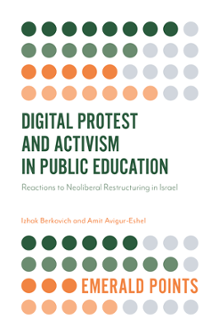
Index
Digital Protest and Activism in Public Education: Reactions to Neoliberal Restructuring in Israel
ISBN: 978-1-83867-105-1, eISBN: 978-1-83867-102-0
Publication date: 1 November 2019
Citation
Berkovich, I. and Avigur-Eshel, A. (2019), "Index", Digital Protest and Activism in Public Education: Reactions to Neoliberal Restructuring in Israel, Emerald Publishing Limited, Leeds, pp. 151-156. https://doi.org/10.1108/978-1-83867-102-020191008
Publisher
:Emerald Publishing Limited
Copyright © Izhak Berkovich and Amit Avigur-Eshel, 2020
INDEX
Index
Note: Page numbers followed by “n” with numbers indicate notes.
- Prelims
- Introduction
- 1: Out with the Old, In with the New: Three Ages of Israeli Public Education Policies
- 2: From Education to All to Education for Me: Changes in Israeli Public Values and Interests
- 3: Rhetoric and Images in Online Agenda Setting: Teachers’ Digital Protest Against Educational Reform
- 4: Two Faces of Digital Activism: Parents’ Anti-Neoliberal and Pro-Neoliberal Protests
- 5: Opening the Black Box of Digital Activism in Education in the Neoliberal Age: Lived Experience and Patterns of Use of Social Media
- Conclusion
- Index